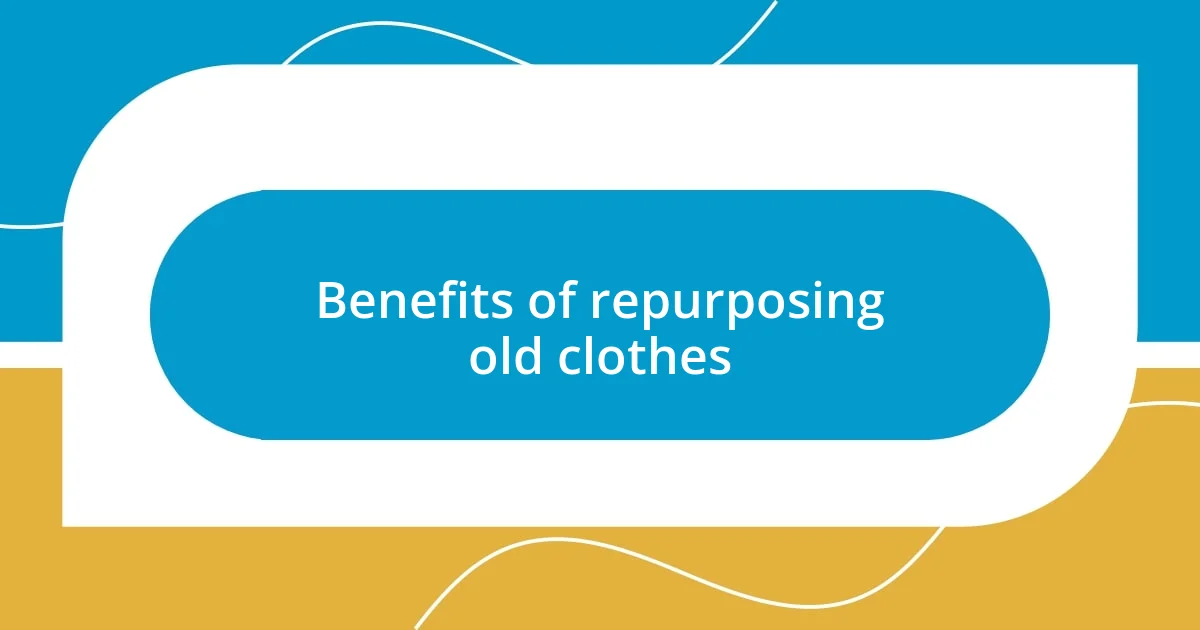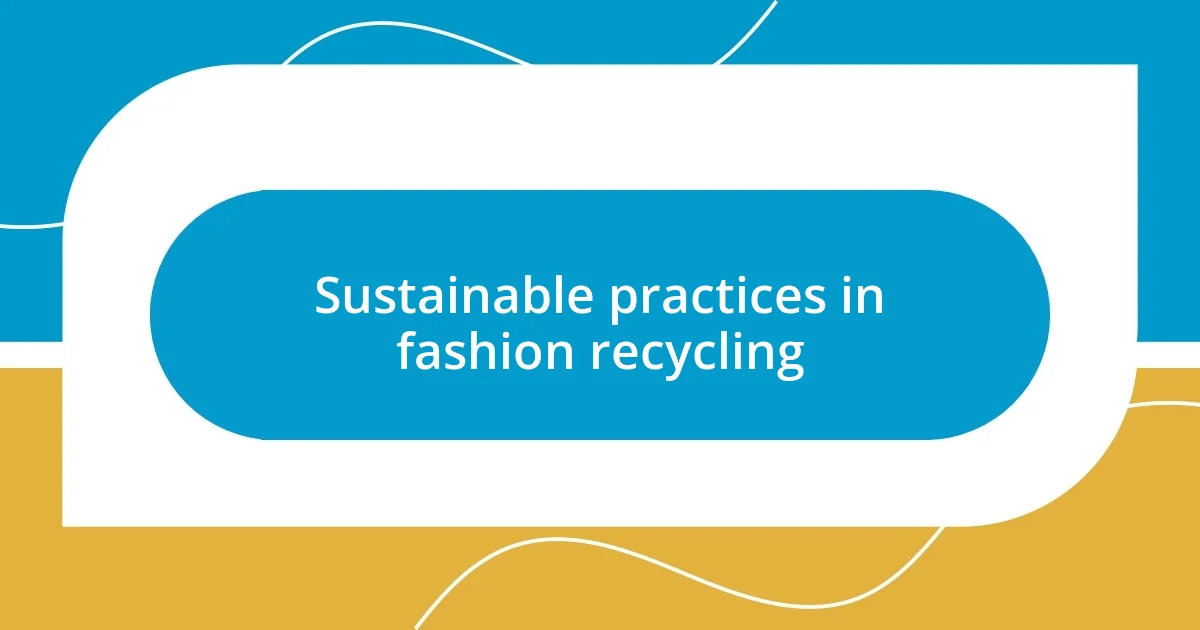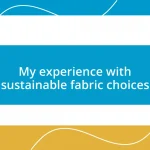Key takeaways:
- Repurposing old clothes creatively reduces waste, promotes sustainability, and allows for personal expression through transformed items.
- Practical benefits of repurposing include cost savings, emotional satisfaction from preserving memories, and fostering resourcefulness.
- Engaging in projects like clothing swaps and visible mending encourages community connections and challenges fast fashion consumption habits.

Understanding the concept of repurposing
Repurposing, at its core, is about breathing new life into items that might otherwise be discarded. I remember the first time I turned an old T-shirt into a stylish tote bag; it felt like giving that shirt a second chance to shine. Isn’t it amazing how something once forgotten can become useful again?
Think about the creative possibilities that repurposing offers. For instance, I transformed a pair of worn-out jeans into cute denim shorts during a summer project last year. It sparked not only curiosity from friends but also a reflection on my consumption habits. How often do we overlook the potential of our possessions, writing them off as trash instead of treasure?
Embracing repurposing is also a way to express individuality and sustainability. I often find myself reminiscing about the memories tied to certain pieces of clothing, and repurposing allows me to preserve those stories. It raises the question: what emotional connections do we have with our items that could inspire us to rethink how we view and utilize them?

Benefits of repurposing old clothes
Repurposing old clothes goes beyond creativity; it contributes significantly to reducing waste. I still recall how transforming an old sweater into a cozy pillow cover not only revived the fabric but also kept it from ending up in a landfill. By giving these items a new purpose, we can effectively minimize our environmental footprint and practice conscious consumption.
In my experience, the financial benefits of repurposing cannot be overlooked. Instead of splurging on new apparel, I’ve diverted my attention to revamping what I already have, like turning a neglected blouse into a vibrant scarf. This approach not only saves money but also fosters resourcefulness, inviting me to think differently about what I own.
Lastly, there’s an undeniable emotional satisfaction in repurposing. Each transformed item carries a story; for instance, I turned my daughter’s outgrown hoodie into a soft blanket she now cherishes. I find joy in giving these clothes a new lease on life while creating pieces that resonate emotionally with my family. What stories will your old clothes tell when creatively repurposed?
| Benefit | Description |
|---|---|
| Environmental Impact | Reduce waste by repurposing items, lessening landfill overcrowding. |
| Cost-Effectiveness | Save money by revitalizing old clothes instead of buying new ones. |
| Emotional Connection | Transform items into meaningful pieces that evoke memories and stories. |

Creative ideas for upcycling clothing
Repurposing clothing is like embarking on a mini adventure every time I dig through my closet. I once took a handful of my son’s old, patterned dress shirts and turned them into a colorful patchwork quilt. The laughter and warmth it brought during family movie nights are memories I cherish deeply. It’s incredible how that quilt now holds not just warmth but snippets of our family’s past, stitched together with love and creativity.
Here are some inspiring ideas you might consider for upcycling your clothing:
- T-Shirt Bag: Turn an old t-shirt into a reusable tote bag for grocery shopping. Just cut and tie, and you’re good to go!
- Upcycled Jewelry: Use buttons, beads, or fabric scraps to create unique necklaces or bracelets that make a personal statement.
- Denim Art: Cut up old jeans to make fabric wall art or embellish a canvas, giving it texture and personality.
- Worn-Out Sweater Mittens: Transform an old sweater into cozy mittens; not only are they warm, but they carry a special memory of the original garment.
- Linen Napkins: Repurpose an old tablecloth or a pair of curtains into chic, reusable linen napkins for your dining table.
The possibilities are endless, and what’s exciting is each project reflects a piece of my identity while fostering a deeper connection to my belongings. What will you create next?

Tools and materials for repurposing
When diving into repurposing old clothes, having the right tools can make a world of difference. A good pair of fabric scissors is essential—I’ve often found that a sharp pair leads to cleaner cuts and saves me the frustration of fraying edges. Also, a reliable sewing machine is a real game-changer. I can’t tell you how many times I’ve whipped up a new item in a matter of minutes, and the satisfaction of seeing it come together is truly unmatched.
As for materials, think beyond just the fabric. I love to gather buttons and zippers from old garments; they can be fantastic embellishments for new creations. Believe me, those little details can completely transform a piece, turning a simple scarf into something that feels like a work of art. Plus, it’s like a treasure hunt every time I dig through my sewing box—what will I find to spark my creativity today?
Finally, don’t underestimate the power of glue. Fabric glue has become my best friend for projects where sewing might be too cumbersome—like creating quirky patches for jackets or even attaching lace trims to old jeans. There’s something liberating about experimenting with different tools and materials; not only does it fuel creativity, but it also creates an emotional attachment to the process. Just imagine the stories waiting to be told through the items you craft! What’s in your toolkit that could inspire your next project?

Step by step upcycling techniques
One of my favorite upcycling techniques is transforming old jeans into a stylish handbag. To do this, I simply cut the jeans into the desired bag shape and use the pockets for functional storage. It’s fulfilling to carry a piece that is not only practical but also carries a story from my closet. Have you ever felt the thrill of turning something outdated into a fashion statement?
Another technique I enjoy involves taking worn-out t-shirts and turning them into vibrant throw pillows. I find that by cutting the fabric into squares and sewing them together, I can create unique designs. It’s a simple project that adds a pop of color to any room, and I love how each pillow sparks a memory of my favorite band or event. How do you think it would feel to surround yourself with items that remind you of cherished moments?
Lastly, I can’t resist the charm of upcycling sweaters into cozy home decor. By crafting them into cozy cushion covers or even a festive table runner, I create warmth not just in terms of temperature but in ambiance as well. The soft texture and nostalgic look remind me of family gatherings during chilly seasons. How might your space change if you introduced these personalized elements?

Showcasing finished repurposed projects
After completing my repurposing projects, showcasing them is always the cherry on top. Recently, I transformed an old sundress into a chic summer tote. When I took it to a picnic, the compliments just kept coming! It’s fascinating how friends often want to hear the backstory of each piece, which makes displaying these items feel even more rewarding. What memories do you think your old clothes could evoke when turned into something new?
I also enjoy setting up a little display at home to highlight my repurposed creations. For example, I hung a few t-shirt pillows on my living room couch. Each pillow tells a story—one reminds me of a concert, while another has the logo from a charity run I participated in. Seeing them every day makes me feel connected to those experiences and gives my space a unique touch. Can you imagine how wonderful it would be to surround yourself with items that tell your personal journey?
Lastly, I love sharing my projects on social media. When I posted a before-and-after of a thrifted jacket I updated with patches and embellishments, the response was overwhelming. Friends chimed in with their appreciation, and even asked for tips to create their own. This interaction truly enhances the joy of repurposing; it’s not just about creating for myself but building a community of like-minded creatives. What about you? How would you feel about sharing your repurposed projects with others?

Sustainable practices in fashion recycling
Sustainable practices in fashion recycling encompass various innovative techniques that not only reduce waste but also breathe new life into unloved garments. From my experience, one impactful approach is the use of fabric scraps to create patchwork designs. I recall sitting with a pile of fabric remnants from past projects, feeling a mixture of guilt for their waste and excitement for the transformation ahead. With some patience and creativity, I stitched them into a vibrant quilt, effectively giving those scraps a new purpose. Isn’t it rewarding to know that something once destined for the landfill can become a cherished item instead?
Another effective practice I’ve embraced is hosting clothing swap events with friends. This not only allows us to refresh our wardrobes but fosters a sense of community and shared sustainability. I remember the buzz of excitement as my friends and I laid out our clothes, eagerly searching for hidden treasures among each other’s unwanted items. There’s something magical about rehoming a beloved piece of clothing; it feels like a story continues rather than ends. Have you ever experienced that joy of finding a perfect item that holds a connection to another person?
Moreover, I’ve found that mending has become a part of my sustainable journey. Rather than discarding a favorite shirt with a small tear, I’ve learned to embrace the art of visible mending, enhancing the garment’s character while prolonging its life. I often reminisce about the soothing rhythm of stitching patches onto worn jeans, each stitch imbuing the piece with a history that is uniquely mine. It feels like a gentle rebellion against the fast fashion cycle. Isn’t it invigorating to think that simple repairs can transform not just a piece of clothing, but the way we view consumption and waste in fashion?














